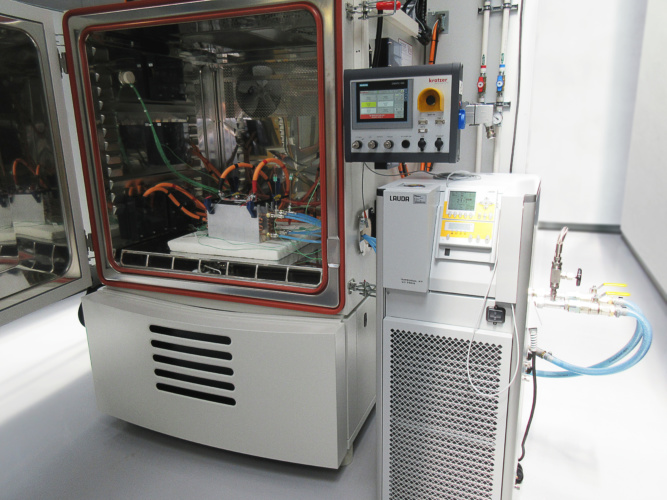The widespread adoption of electric vehicles is dependent on ease of use: rapid charging is a key factor. However, this comes with significant challenges for safety and can speed up Lithium-ion battery degradation, reducing performance and life.
As EV take-up increases, not everyone will have access to overnight charging at home. Those needing to charge on-the-go using public charging infrastructure will want this process to happen as quickly as possible. To maintain convenience and align with our expectations learned from internal combustion engine vehicles, a target for vehicle manufacturers is to make recharging as quick as filling with petrol. However, Lithium-ion (Li-ion) batteries are extremely sensitive and rapid charging accelerates battery degradation in some circumstances. Moreover, individual usage patterns will result in unique battery ageing that increases the complexity of providing appropriate solutions.
Causes of degradation
Three of the key factors that contribute to degradation in Li-ion batteries are temperature, state of charge (SoC) and charge current, with each of these having a different effect on how the cell ages.
When a Li-ion cell is operating at a higher than optimal temperature the rate of solid electrolyte interphase (SEI) layer formation and growth can increase leading to heightened lithium consumption. It can also cause a higher rate of cathode oxidisation that results in loss of positive electrode active material. Both phenomena degrade battery performance and life. At the other end of the scale, if the temperature is too low there is the potential of lithium plating. This is the formation of lithium metal deposits on the surface of the anode, which causes rapid degradation and can result in hazardous conditions that pose a safety concern such as thermal runaway.
Cloud-based battery management has the potential to enable faster, safer charging without reducing battery life
State of charge is the ratio of the amount of charge stored in a battery relative to the total charge that battery can store. At high SoC, the increased instability between electrode and electrolytes can cause increased chemical reactions. This accelerates degradation of the electrolyte and both active materials. Low SoC can also cause degradation due to contraction and subsequent damage to the negative electrode and surrounding SEI layer.
High charging currents can also contribute to degradation, particularly at low temperatures. Higher charging currents cause greater average current density at the negative electrode. This lowers the negative electrode potential, which in turn increases the propensity of lithium plating. This can cause rapid degradation and creates risk of thermal runaway. It is heavily dependent on cell temperature and the current magnitude seen by the anode during charge: the higher the charge current and lower the temperature, the bigger the risk. If conditions are favourable for lithium to plate on the anode surface quickly, it can form dendrites, metallic microstructures that consume lithium, increase resistance and pose a safety risk.
Mitigating degradation
The considerable scope of influencing factors such as temperature, SoC and current result in a wide variation of Li-ion battery ageing characteristics. Sensitivity to these parameters is also highly design dependent, with individual cell designs behaving differently. But, by using vehicle data to determine the complex changes in cell performance and its principal causes, it is possible to mitigate degradation.

HORIBA MIRA has comprehensive testing and engineering capabilities for battery systems and its Electrification & Energy Efficiency team has been exploring this idea, developing a novel approach to cloud-based battery management. By utilising vehicle data, the battery management system can be continuously recalibrated for optimum performance, safety and life.
This approach comprises both on-vehicle and off-vehicle analysis. A baseline charging profile is developed for the vehicle with on-board analysis evaluating capacity and power fade state of health metrics. When there is deviation from the original beginning of life characteristics, the data is passed to the cloud when the vehicle is plugged in during rapid charging.
In the cloud, incremental capacity analysis (ICA) is used to investigate the capacity and health of the Li-ion batteries. This approach goes beyond standard state of health estimation. The cloud-based evaluation algorithm can distinguish the type of degradation. In this case of capacity fade, this is from three main types: loss of lithium, negative electrode active material loss, or positive electrode active material loss. The combination of the capacity and resistance change symptoms can then be used to identify the root cause of the Li-ion cell ageing.
Creating EV differentiation
With this information it is possible to recalibrate the battery management system for the unique challenges of that individual vehicle. New rapid charging current limits are set and an optimised charging strategy is created. With continuous recalibration of the battery management system on a vehicle-by-vehicle basis, maximum charging capability can be achieved while offering protection against lithium plating.
Cloud-based battery management has the potential to enable faster, safer charging without reducing battery life. Moreover, it’s agnostic, so applicable to any Li-ion cell chemistry or format. For vehicle manufacturers, this solution to battery degradation has the potential to create differentiation amongst EVs, providing a competitive advantage in terms of enhanced convenience, reduced recharging times and without compromising warranty, performance or battery life.











Water Sector Talent Exodus Could Cripple The Sector
Maybe if things are essential for the running of a country and we want to pay a fair price we should be running these utilities on a not for profit...